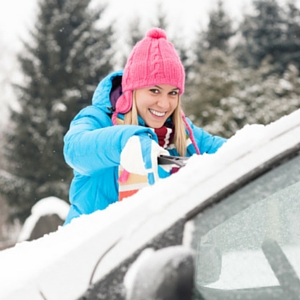Winter Driving Tips

When you were a kid, you probably got excited when winter storms hit because it usually meant school would be closed, and you could spend the day building a snowman and drinking hot chocolate. As an adult, you probably dread reports of severe weather because you worry about what road conditions will be like getting to and from work. When the weather turns cold, it's a good time to review these winter driving tips.
First Things First
Before the first snowfall, there are a few things you need to do to make sure your car is ready for winter:
- Make sure your tires are properly inflated and check them periodically throughout the winter. If they are over- or under-inflated, they won't grip the road properly.
- Keep a winter emergency kit in your car that includes:
- An ice scraper with a brush on one end
- Windshield de-icer
- A flashlight
- Jumper cables
- A small shovel
- Sand, rock salt or kitty litter
- A blanket
- Non-perishable snacks
- A cell phone charger
- Make sure your car has enough anti-freeze
- Make sure your windshield washer reservoir is full of the type of windshield washer fluid that contains de-icer—NOT plain water.
- Make sure your wiper blades are in excellent condition.
Driving in Slippery Conditions
If you're driving in snow, ice or rain, extra precautions need to be taken. When you get to your car, start it and turn the defrosters on. Then get out and scrape the snow and ice off all the windows, headlights, taillights and side mirrors. It's even important that you remove snow from the roof of your car and the hood. Visibility is extremely important—this is an important time to see and be seen.
Distance Yourself
As you're driving, keep more distance than usual between your car and the car in front of you. It's highly likely that when you brake, your car might keep sliding. The extra distance will help prevent an accident.
Brake Time
Speaking of brakes, know what type your car has. If it doesn't have an anti-lock brake system, you need to pump the brakes to stop on snow or ice. If you do have ABS, use them as you normally would. Pumping the brakes when you have ABS will disengage the ABS system. In all cases, try to avoid situations in which you have to slam on the brakes, even when the weather is good.
Slip Slidin' Away
Hitting a patch of black ice or driving too fast for conditions can send your car spinning. Even if you are driving carefully, it can happen during a turn or if you are trying to avoid hitting something. Although it's counterintuitive, if you find yourself in a skid, turn your steering wheel the opposite direction of the skid. For instance, if your back wheels are sliding to the left, turn your steering wheel to the left.
Finally, don't use cruise control. Using cruise control in the snow, ice or even rain is dangerous because if your car hydroplanes or skids, it will accelerate and rapidly spin the wheels since it will be trying to maintain a constant speed. If this happens, it will be more likely that you lose control of your vehicle.
What to Do if You Get Stuck
Nobody wants to get stuck in the snow, but if you do, don't hit the gas—it will only get you in deeper. Besides, you will only spin your tires, which can damage them. Instead, use the shovel from your emergency kit to remove the snow in the front and back of your tires away from the vehicle. Next, put some sand, rock salt or kitty litter in front of and behind your tires for traction so you can drive out.
Of course, if you don't have to drive in bad winter weather conditions, it's best to stay at home. But if you do have to go out, allow yourself plenty of extra time to reach your destination and remember these tips.
